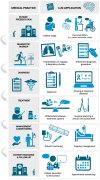Clinical and Surgical Applications of Large Language Models: A Systematic Review
- PMID: 38892752
- PMCID: PMC11172607
- DOI: 10.3390/jcm13113041
Clinical and Surgical Applications of Large Language Models: A Systematic Review
Abstract
Background: Large language models (LLMs) represent a recent advancement in artificial intelligence with medical applications across various healthcare domains. The objective of this review is to highlight how LLMs can be utilized by clinicians and surgeons in their everyday practice. Methods: A systematic review was conducted following the Preferred Reporting Items for Systematic Reviews and Meta-Analyses guidelines. Six databases were searched to identify relevant articles. Eligibility criteria emphasized articles focused primarily on clinical and surgical applications of LLMs. Results: The literature search yielded 333 results, with 34 meeting eligibility criteria. All articles were from 2023. There were 14 original research articles, four letters, one interview, and 15 review articles. These articles covered a wide variety of medical specialties, including various surgical subspecialties. Conclusions: LLMs have the potential to enhance healthcare delivery. In clinical settings, LLMs can assist in diagnosis, treatment guidance, patient triage, physician knowledge augmentation, and administrative tasks. In surgical settings, LLMs can assist surgeons with documentation, surgical planning, and intraoperative guidance. However, addressing their limitations and concerns, particularly those related to accuracy and biases, is crucial. LLMs should be viewed as tools to complement, not replace, the expertise of healthcare professionals.
Keywords: ChatGPT; artificial intelligence (AI); deep learning; diagnosis; machine learning; management; surgical specialties.
Conflict of interest statement
The authors declare no conflicts of interest.
Figures




Similar articles
-
A Systematic Review of ChatGPT and Other Conversational Large Language Models in Healthcare.medRxiv [Preprint]. 2024 Apr 27:2024.04.26.24306390. doi: 10.1101/2024.04.26.24306390. medRxiv. 2024. Update in: J Med Internet Res. 2024 Nov 7;26:e22769. doi: 10.2196/22769. PMID: 38712148 Free PMC article. Updated. Preprint.
-
Large language models for conducting systematic reviews: on the rise, but not yet ready for use-a scoping review.J Clin Epidemiol. 2025 May;181:111746. doi: 10.1016/j.jclinepi.2025.111746. Epub 2025 Feb 26. J Clin Epidemiol. 2025. PMID: 40021099
-
The role of large language models in medical image processing: a narrative review.Quant Imaging Med Surg. 2024 Jan 3;14(1):1108-1121. doi: 10.21037/qims-23-892. Epub 2023 Nov 23. Quant Imaging Med Surg. 2024. PMID: 38223123 Free PMC article. Review.
-
Large Language Models and User Trust: Consequence of Self-Referential Learning Loop and the Deskilling of Health Care Professionals.J Med Internet Res. 2024 Apr 25;26:e56764. doi: 10.2196/56764. J Med Internet Res. 2024. PMID: 38662419 Free PMC article.
-
Large Language Models for Mental Health Applications: Systematic Review.JMIR Ment Health. 2024 Oct 18;11:e57400. doi: 10.2196/57400. JMIR Ment Health. 2024. PMID: 39423368 Free PMC article.
Cited by
-
Building an intelligent diabetes Q&A system with knowledge graphs and large language models.Front Public Health. 2025 Feb 20;13:1540946. doi: 10.3389/fpubh.2025.1540946. eCollection 2025. Front Public Health. 2025. PMID: 40051508 Free PMC article.
-
Large language models for disease diagnosis: a scoping review.NPJ Artif Intell. 2025;1(1):9. doi: 10.1038/s44387-025-00011-z. Epub 2025 Jun 9. NPJ Artif Intell. 2025. PMID: 40607112 Free PMC article. Review.
-
What is the role of large language models in the management of urolithiasis?: a review.Urolithiasis. 2025 May 15;53(1):92. doi: 10.1007/s00240-025-01761-w. Urolithiasis. 2025. PMID: 40372452 Review.
-
Evaluating the Efficacy of Large Language Models in Guiding Treatment Decisions for Pediatric Refractive Error.Ophthalmol Ther. 2025 Apr;14(4):705-716. doi: 10.1007/s40123-025-01105-2. Epub 2025 Feb 22. Ophthalmol Ther. 2025. PMID: 39985747 Free PMC article.
-
Assessment of artificial intelligence performance in answering questions on onabotulinum toxin and sacral neuromodulation.Investig Clin Urol. 2025 May;66(3):188-193. doi: 10.4111/icu.20250040. Investig Clin Urol. 2025. PMID: 40312898 Free PMC article.
References
-
- Manning C. Artificial Intelligence Definitions. Stanford University Human-Centered Artificial Intelligence. [(accessed on 18 October 2023)]. Available online: https://hai.stanford.edu/sites/default/files/2020-09/AI-Definitions-HAI.pdf.
-
- Muftić F., Kadunić M., Mušinbegović A., Abd Almisreb A. Exploring Medical Breakthroughs: A Systematic Review of ChatGPT Applications in Healthcare. Southeast Eur. J. Soft Comput. 2023;12:13–41. doi: 10.21533/scjournal. - DOI
-
- Jin Z. Analysis of the Technical Principles of ChatGPT and Prospects for Pre-trained Large Models; Proceedings of the 2023 IEEE 3rd International Conference on Information Technology, Big Data and Artificial Intelligence (ICIBA); Chongqing, China. 26–28 May 2023; pp. 1755–1758.
-
- Mikolov T., Karafiát M., Burget L., Cernocký J., Khudanpur S. Recurrent neural network based language model. Interspeech. 2010;2:1045–1048.
Publication types
Grants and funding
LinkOut - more resources
Full Text Sources

